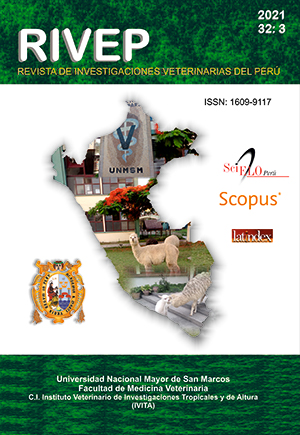Characterization of llama rearing in the Pasco region, Peru
DOI:
https://doi.org/10.15381/rivep.v32i3.18030Keywords:
production systems, llama, herd structure, selection criteriaAbstract
The aim of this study was to describe the system for rearing llama populations in communal cooperatives (CC) and by individual farmers (IF) in the Pasco region, Peru. Field surveys were applied to four CC administrators and 145 IF. The main breeding objective for CCs and IFs was meat production. The K'ara type llama predominated in CC and the Intermediate type in IF. The average herd size in CC was 200 and in IF 48 llamas. Mating in CC was controlled and in IF generally uncontrolled. The age at first service of males and females in CC and IF was 34.5 and 23.5, and 26.3 and 23.1 months, respectively, with a male: female ratio of 1.13 in CC and 1.18 in IF. The average permanence of males and females in the herd was 2.54 and 8.0 in CC and 4.14 and 9.6 years in IF, respectively. Male and female replacements came from the same herd in 70 and 75% in CC and in 83.6 and 98.3% in IF, respectively. The sale of male for breeding was mainly destined to neighbouring farms in 80 and 65% in CC and IF, respectively. The selection practice of males and females was done in 26.9 and 16.6% of the IF, respectively. The selection of males and females was at 6.5 months in CC and at 11.3 and 14.0 months of age for males and females, respectively, in IF. The main criterion for selection was the body size.
Downloads
Downloads
Published
Issue
Section
License
Copyright (c) 2021 Aníbal Raúl Rodriguez Vargas, Gustavo Augusto Gutierrez Reynoso, Maria Wurzinger

This work is licensed under a Creative Commons Attribution 4.0 International License.
AUTHORS RETAIN THEIR RIGHTS:
a. Authors retain their trade mark rights and patent, and also on any process or procedure described in the article.
b. Authors retain their right to share, copy, distribute, perform and publicly communicate their article (eg, to place their article in an institutional repository or publish it in a book), with an acknowledgment of its initial publication in the Revista de Investigaciones Veterinarias del Perú (RIVEP).
c. Authors retain theirs right to make a subsequent publication of their work, to use the article or any part thereof (eg a compilation of his papers, lecture notes, thesis, or a book), always indicating the source of publication (the originator of the work, journal, volume, number and date).










